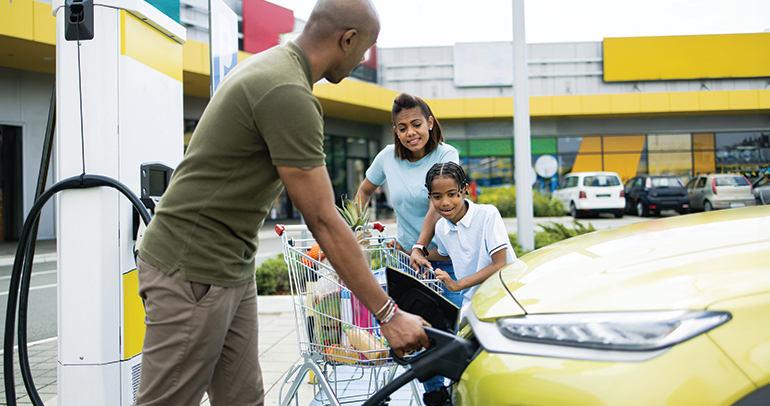
Technology is so tightly woven into the fabric of our lives, most times it’s hard to remember how we ever lived without it. At home, you can turn on your TV, spin up a movie, order groceries and schedule a bank transfer with a simple voice command. Use your smartphone to enter a convenience store, choose your products and be on your way without passing through a checkout. Or, take a virtual reality (VR) trip across the world from the comfort your living room.
From healthcare and travel to entertainment and education, technology has transformed entire industries by introducing efficiencies, innovation, new business models and novel customer experiences. And it’s changed our relationship with just about everything—including the cars we drive. The latest technology advances help us stay safer, monitor maintenance issues, and make driving more enjoyable.
As auto and mobility manufacturers have struggled to sell battery electric vehicles (BEVs)—also known as EVs—it may be in part because they’re too tied to the traditional utility of the car rather than how this new technology can improve consumer lives in more meaningful ways.
The convergence of tech and car culture is a golden opportunity to change consumer perceptions about BEVs. Going beyond environmental benefits, conversations that focus on cutting-edge technology, driver convenience, lower cost of ownership and just plain fun have the potential to move the BEV needle and propel growth in ways we’ve not yet seen.
Once automakers can change the conversation and reposition their cars in the eyes of the consumer, the BEV market has the potential to finally crank into high gear.
The Cool Factor
Before the proliferation of technology, car enthusiasts and tech fans seemed to gravitate toward very different things. While one group valued power trains and fuel injections, the other prized gadgets and the latest software or hardware releases. Sure, both tinkered with “technology,” but they would never be considered cut from the same cloth.
Today, that distinction is being blurred, and it’s something automakers should pay attention to. The mass market for cars is highly commoditized with small things used to differentiate, but for the “car enthusiast” persona, there’s still a market of classic cars and premium cars out there. By adding new and sophisticated tech—such as electric propulsion, radar cruise and torque braking—automakers can separate the commoditized middle and the high-end car persona with a new segment: the tech-car enthusiast.
Because, when it comes to buying a car, it’s really not about the car. It’s about the technology. How it looks, feels and makes you feel.
Case in point: Tesla. Maker of the best-selling BEVs in the world, the Tesla name has become synonymous with electric cars—and cool! Recently, its 2019 Tesla Model 3 has been named the top-rated electric car for 2020 by Edmunds.com, and drivers in Norway named the Model 3 as their favorite car for 2020—over other BEVs and internal combustion engine (ICE) vehicles.
In addition to their cars, Tesla’s key to success lies in the way they’ve positioned those cars to consumers. The BEV leader has worked to build a lifestyle brand rather than an electric car, appealing to consumer desire for style, luxury and the latest technology.
According to our research, 47% of European consumers say that “cool technology” gives BEVs an advantage over ICE vehicles. With a large touchscreen tablet console, the ability to stream content like Netflix and Spotify, smart sensors to monitor potential damage to your car (like keying) and self-driving capabilities, owning a Tesla is much like having the latest trendy tech gadget.
An LA Times article even suggests that having an electric car isn’t all that important to Tesla buyers: “Some analysts think buyers don’t necessarily want an electric car when they buy a Tesla—they primarily want a Tesla, which has replaced the latest iPhone as the coolest accoutrement in Silicon Valley and similar cultural enclaves around the world.”
Tesla has built its brand and following around the merits of its technology and consumer preferences, and it’s a strategy worth replicating. Other BEV makers, from Nissan to Audi, have followed suit, incorporating technologies like wireless charging, voice recognition, the ability to find your car remotely, smart cameras, and automatic seating and climate control adjustments based on the recognized driver.
Enjoying the Ride
One of the things that is not talked about much is how fun BEVs are to drive. When you step on the gas, they immediately go—they are “excitingly responsive.” The cabin is so quiet, it’s been described as an “oasis of calm.” And because BEVs hug the road more tightly than internal combustion engine vehicles, some say BEVs are as fun to drive as a go-cart.
Importantly, our research shows that consumers consider a quiet, smooth ride one of the top advantages BEVs have over ICE vehicles. Here are some other functional and emotional benefits that are not often discussed or used in the sales process:
- It’s Like a Game: One writer describes how driving an BEV feels like a game: “You can’t drive a certain way and bring in more fuel in an internal-combustion engine vehicle; your fuel gauge only goes one direction: down … But driving an EV, I was hooked—driving could essentially become a game, saving me money and energy as the battery recharged when I slowed down or naturally sped up heading down a hill.” Similarly, there are likely some drivers who get pleasure out of gamifying where they’ll charge up when taking their BEV on a long trip.
- Say “Goodbye Maintenance”: Imagine the thrill of knowing that you’ll never have to take your car in for an oil change again. (And you can secretly gloat as you see your neighbor pull into Jiffy Lube.) As BEV technology replaces many of the moving parts characteristic of ICE vehicles, consumers can bid farewell to oil changes, filter replacements, failing belts and hoses, and other routine maintenance issues.
- Stop Worrying About When You Are Going to Fuel Up: Think about how in control you’d feel knowing your car is always “topped off.” With an BEV, you essentially own the ability to fuel your car. And, if you can charge at home, work or in public places, you may never have to stop to “fuel up” again.
Don’t Forget the Cost
Currently, several BEVs are competing in the luxury car market with a price point and feature set targeting consumers with luxury in mind. Those accustomed to luxury cars expect cool features included in the price premium, but traditional ICE cars tend to have expensive maintenance requirements and depreciate at similar rates to standard cars.
For BEVs, there already exists financial incentives, government subsidies, cheaper fuel and fewer maintenance concerns to help drive down total cost of ownership. What remains to be seen is the resale value and depreciation of BEVs relative to their ICE counterparts. So, when factoring in the total cost of ownership in addition to the cool features, the scales may tip toward BEVs for some buyers.
In fact, Deloitte predicts that by 2022, advances in technology will help equalize the costs of owning a BEV vs. a traditional vehicle. An aggressive prediction to be sure, but as battery costs decrease and production methods improve, costs are coming down. How quickly costs balance with ICE vehicles remains to be seen.
A New Point of View
BEVs have so much more to offer consumers than automakers give them credit for. Rather than positioning them as electric versions of ICE vehicles, it’s time to focus on what consumers really want and how those cars make them feel. GM, Porsche and Audi seem to be getting the message. The three BEV automakers ran Super Bowl ads that got viewers’ hearts pumping with the sights and sounds of a high-speed car heist, a shattering backboard, and an adrenaline-charged power ballad. They were all about cool first, car second.
By helping buyers look at BEVs in a different light, not only will these cars appeal to a wider range of consumers—including the tech-car enthusiast—but the BEV market as a whole might just get the boost it needs to leave ICE vehicles behind.
If you’d like to know more about how your business can thrive in this emerging landscape, we can help. Read our white paper The Future of BEV: How to Capture the Hearts and Minds of Consumers to learn what it will take for auto manufacturers and tech companies to make an BEV with functional and emotional benefits that will have mass appeal.








